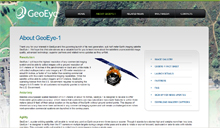Posted by //
Sean
Date and Time //
Sep 8, 08 - 9:02 am
Categories //
Geekery
Google
Technology
RSS Feed //
RSS 2.0
 Google has expanded its reach into space with the successful launch Saturday of a new satellite that will provide the company with exclusive images for its maps.
Google has expanded its reach into space with the successful launch Saturday of a new satellite that will provide the company with exclusive images for its maps.
After an 11:50 a.m. takeoff from Vandenberg Air Force Base in California, the GeoEye-1 satellite relayed a downlink signal to a ground station in Norway, confirming that it had separated from its United Launch Alliance Delta II rocket and had begun to initialize its onboard systems.
The satellite launch was coordinated by terrain mapping company GeoEye. “Based upon the data we saw, the satellite is performing properly and ready to begin the next phase towards meeting its mission requirements,” said Bill Schuster, GeoEye chief operating officer, in a statement.
GeoEye said the 4,310-pound satellite required calibration and check-out period before the company would sell its images.
Although GeoEye did not mention Google in any of its announcements regarding the satellite, the search engine giant’s name appeared on the satellite and company founders Sergey Brin and Larry Page attended the launch, according to reports.
GeoEye said it plans to sell the images to customers around the world, but a Google spokesperson said that Google has exclusive rights to the images for commercial maps.
“The imagery from GeoEye-1 adds to the quantity and quality of that currently provided by our IKONOS satellite, and together this magnificent constellation will enable us to meet world-wide customer demand,” Matthew O’Connell, GeoEye CEO, said.
GeoEye-1 is part of the National Geospatial-Intelligence Agency (NGA), NextView program, which aims to obtain timely and accurate commercial satellite imagery.
It will collect 0.41-meter ground resolution black and white images and 1.65-meter color images simultaneously. It can show objects as small as 16 inches. U.S. licensing restrictions limit commercial images to a half-meter ground resolution.
The satellite can capture the images from 423 miles above the Earth and travel about 4.5 miles per second.
General Dynamics Advanced Information Systems in Gilbert, Ariz., built the satellite, while ITT in Rochester, N.Y., developed the imaging system. ITT is building another imaging system for GeoEye-2, which is scheduled to launch in 2011.
GeoEye said it won a $500 million NextView contract four years ago, and it built and launched the satellite with no cost overruns.
Source: GeoEye-1 Launch Site
This entry was posted on Monday, September 8th, 2008 at 9:02 am and is filed under Geekery, Google, Technology. You can follow any responses to this entry through the RSS 2.0 feed.
Both comments and pings are currently closed.
No Comments
Comments are closed.